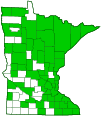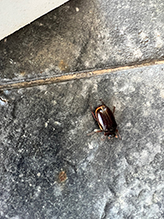May beetles
(Phyllophaga spp.)
Overview • Description • Distribution • Taxonomy
Description |
Adults are orangish-brown to dark brown. Most have little or no hair on the upper surface. At least 20 Phyllophaga species occur in Minnesota, and many very similar in appearance. They are distinguished by
Unfortunately, none of these characters are visible in most photos. For this reason, identification from photos is usually made only to the genus level. |
Distribution |
||
|
Sources |
|
| 6/9/2024 | ||
Taxonomy |
|
Order |
Coleoptera (Beetles) |
Suborder |
Polyphaga (Water, Rove, Scarab, Long-horned, Leaf, and Snout Beetles) |
Infraorder |
Scarabaeiformia |
Superfamily |
Scarabaeoidea (Scarabs, Stag Beetles, and Allies) |
Family |
Scarabaeidae (scarabs) |
Subfamily |
Melolonthinae (June beetles) |
Tribe |
Rhizotrogini |
Subordinate Taxa |
|
Subgenus Chlaenobia May beetle (Phyllophaga vexata)
Subgenus Cnemarachis Cuban May beetle (Phyllophaga bruneri)
Subgenus Phyllophaga Clemens’ May beetle (Phyllophaga clemens) crenulated chafer (Phyllophaga crenulata) diurnal scrub June beetle (Phyllophaga okeechobea) Drake’s chafer (Phyllophaga drakei) eastern chafer (Phyllophaga balia) Elizoria June beetle (Phyllophaga elizoria) elongate June beetle (Phyllophaga elongata) fiery chafer (Phyllophaga fervida) fluffy chafer (Phyllophaga ilicis) forest-ogre June beetle (Phyllophaga anxia) fraternal chafer (Phyllophaga fraterna) hairy chafer (Phyllophaga hirticula) hairy-fronted chafer (Phyllophaga vilifrons) inverted chafer (Phyllophaga inversa) lanceolated chafer (Phyllophaga lanceolata) lesser June beetle (Phyllophaga futilis) long-spined chafer (Phyllophaga longispina) margined chafer (Phyllophaga marginalis) May beetle (Phyllophaga albina) May beetle (Phyllophaga benwarneri) May beetle (Phyllophaga bipartita) May beetle (Phyllophaga congrua) May beetle (Phyllophaga corrosa) May beetle (Phyllophaga ephilida) May beetle (Phyllophaga fimbripes) May beetle (Phyllophaga forsteri) May beetle (Phyllophaga horni) May beetle (Phyllophaga implicita) May beetle (Phyllophaga prunina) May beetle (Phyllophaga sociata) northern June beetle (Phyllophaga fusca) oval June beetle (Phyllophaga ovalis) rugose June beetle (Phyllophaga rugosa) shaggy chafer (Phyllophaga hirsuta) shiny chafer (Phyllophaga nitida) Skelley’s June beetle (Phyllophaga skelleyi) slender chafer (Phyllophaga gracilis) southern Lake Wales Ridge June beetle (Phyllophaga panorpa) turf chafer (Phyllophaga tristis) Yemassee June beetle (Phyllophaga yemasseei) Young’s June beetle (Phyllophaga youngi)
Subgenus Phytalus May beetle (Phyllophaga bilobatata) May beetle (Phyllophaga blanda) May beetle (Phyllophaga georgiana) May beetle (Phyllophaga obsoleta) May beetle (Phyllophaga sonora) May beetle (Phyllophaga trichodes)
Subgenus Tostegoptera brown scarab beetle (Phyllophaga lanceolata) May beetle (Phyllophaga squamipilosa) |
|
Synonyms |
|
Abcrana Chirodines Clemora Cnemarachis Endrosa Eugastra Gynis Gynnis Tostegoptera Trichestes |
|
Common Names |
|
chafers June beetles June bugs May beetles |
|
Visitor Photos |
||
Share your photo of this insect. |
||
This button not working for you? |
||
Brian Tasky |
||
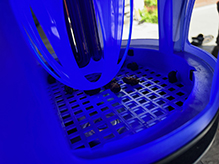 |
||
Luciearl |
||
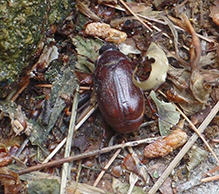 |
|
|
MinnesotaSeasons.com Photos |
||
|
||
|
||

Slideshows |
June Bugs (Phyllophaga) |

|
May-June Beetles - Phyllophaga sp. |
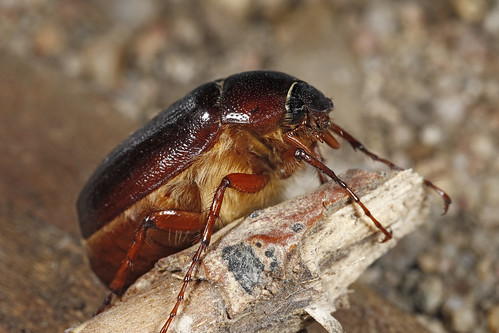
|
About
Melolonthinae (May Beetles and Junebugs) |

Visitor Videos |
||
Share your video of this insect. |
||
This button not working for you? |
||
|
Other Videos |
||
May Beetle (Scarabaeidae: Phyllophaga) Locomotion |
About
Published on Apr 25, 2010 This scarab beetle was photographed at Grand Forks, North Dakota (24 April 2010). |
How to identify a cockchafer May bug | Natural History Museum |
About
Published on May 22, 2012 It doesn't only fly in May and it isn't actually a bug, but the cockchafer can be seen at the moment and is pretty easy to spot, being the UK's largest chafer beetle. When seen for the first time, an adult cockchafer can cause a bit of a stir and lots of people find them a little worrying, according to Stuart Hine of the Natural History Museum's Identification and Advisory Service (IAS). If you spot anything unusual, get it identified by Museum experts and other enthusiasts on our Identification forums: http://www.nhm.ac.uk/identification |
June bug facts you might not know |
About
Published on Aug 2, 2016 http://www.rovepestcontrol.com/50off June bug facts you might not know We have been having an unusually long and active June Bug season this summer and have been getting a lot of questions about them, so here are a few June Bug facts and information you might not know! June Bug Facts June Bugs get their name primarily because most often it is when their eggs start to hatch. It most often ranges from end of may to end of June/early July. June Bug’s larva can live from 2-4 years underground before becoming full grown adult beetles. These bugs are frequently viewed as pests because they do damage both as larva and as adult beetles. There are several species of beetles that are considered “June Bugs” but the most common ones are the Japanese Beetle, Chafer Beetle, Green June Beetle, and Ten Line June beetle. What June bugs eat June bug larva tend to do damage to plant roots as well as grass. They like to eat roots in several plants, like trees, grass, and grains. The larva also really likes to eat plants you may have in your gardens like berries and potatoes, tomatoes, etc. You may have a larva problem if you are seeing several brown patches in your yard. The grass will often peel off very easily without much effort if you have a significant issues with June bug larva. An interesting way to check if you may have an issue is you can flood the affected areas with water and then the larva tends to come up to the surface. Adult June bugs eat the foliage on different plants and shrubs. They have been known to feed on well over 300 different species of plants. Many of these pests are very active at night and are attracted to lights. If you have yard lights June bugs are often found around them. Common June Bug treatments There are a couple options to get rid of June bugs, you can either make pest’s shelter less easy to live in or what they eat less desirable, the later is often the best solution. In other instances strategic pruning of the plant or surrounding plants may produce the desired result. Depending on how far along the season is, you may need to focus on the adult stage vs controlling the larval stage. At certain times of the year, products that move through tree, shrub, and flower internal systems may be injected into the soil in dosages that will protect the plant from invading and attacking insects without threatening the health of the plant. Other times the treatment is more focused on the larva. We suggest reaching out to a pest control specialist to determine what the best route would be for your pest issues. Have a question for us? Be sure to reach out on Facebook: www.facebook.com/RoveMinnesota P.S. Have a pest issue? As a first time customer with Rove Pest Control – |
May Beetle |
About
Published on May 16, 2017 Shrikant Kelkar's video clip taken at Kalwa, Maharashtra, India in March 2017 Family : Scarabaeidae ; Subfamily : Melolonthinae ; Genus : Phyllophaga OR Binomial Name : Leucopholis lepidophora ; Family : Melolonthidae |

Visitor Sightings |
||
Report a sighting of this insect. |
||
This button not working for you? |
||
Brian Tasky |
Location: Hermantown, MN |
 |
| Nicola Prehn 6/5/2019 |
Location: MN 56063 (Blue Earth County) |
|
| Luciearl 1/4/2018 |
Location: Lake Shore, MN |
 |
MinnesotaSeasons.com Sightings |
||
|

Created: 1/7/2018 Last Updated: © MinnesotaSeasons.com. All rights reserved. |
